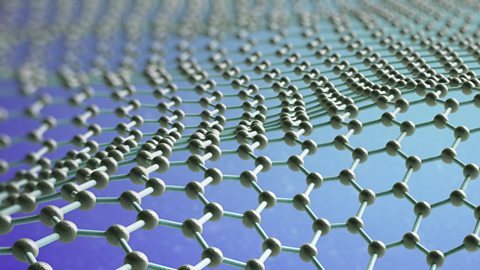Smart, modern and composite materials
The differences between smart, modern and composite materials
What is a modern material?
Many modern materials are developed for specialist applications; however, some have become available for general use.
concreteA particle-based composite made from cement and sand. Often combined with an aggregate such as stones or pebbles or reinforced with steel rods., aluminiumA chemical element often used for making drinks cans. and steelA ferrous metal composed of iron with small amounts of carbon to increase the strength. are all commonly used modern materials, but more recent additions include materials that have changed the way we manufacture and use products.
Graphene is a single carbon layer material which is hypothetically 100 times stronger than steel. It is hypothetical because we are yet to manufacture it in large enough quantities to prove this. In theory, it could provide body armour that is bulletproof, invisible and almost weightless.
If the whole of Wembley Stadium was covered in a layer of graphene, it would be almost invisible and be unbreakable, yet it could all be lifted it with one finger.

liquid crystal display (LCD)A visual display that uses liquid crystals. use the light-modulatingA beam of light is controlled using an optical modulator, which can control the current that powers the light source. properties of liquid crystals to display an image. The liquid crystals are between a liquid and solid state. When charge is applied to each liquid crystal, the shape changes to either block light or let light through. This ensures text or images display on the LCD.
LCDs require a backlight to work and many modern devices now use organic light-emitting diodes (OLEDs) instead, which allows devices to be thinner and lighter. OLEDs are more expensive as each pixel is its own light, but they allow for thinner panels and better colour and contrastThe difference between lightness and darkness. An image with high contrast has very light (white) areas and very dark (black) areas. An image with low contrast is more grey..
Nanomaterials are tiny particles of 1 to 100 nanometres (nm) that can be used in thin films or coatings such as the oleophobicA nanomaterial applied to a surface to repel oil and fingerprints. coatings on smartphoneA mobile phone with a powerful processor that is capable of running applications and accessing the internet. screens that repel greasy fingerprints, or hydrophobicA nanomaterial applied to a surface to repel water. materials that repel water.

Breathable fabrics are designed to allow body moisture to evaporate away from the body, through the use of a breathable membrane laminatedAt least two layers of material bonded together. between layers of fabric, whilst still remaining waterproof. The membrane has microscopic holes, big enough to let body moisture through but too small for rain, and it is often used in tents and waterproof walking gear. Examples include Gore-Tex, Permatex and SympaTex.